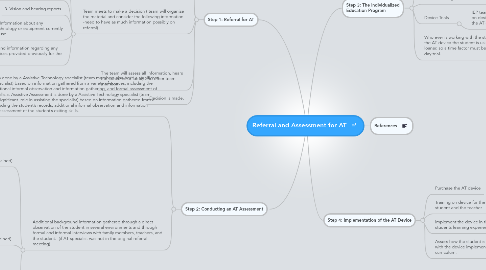
1. Step 1: Referral for AT
1.1. Referral is made(by parents, physician, school, or the student may already be receiving special education and already has an IEP)
1.2. Referral is put in place.
1.3. Team meets to make a decision ( team will organize the material and consider the following information -need to have as much information possibly on referral)
1.3.1. 1. Student data or personal information
1.3.2. 2. Medical data for vital concerns
1.3.3. 3. Vision and hearing reports
1.3.4. 4. Information about any technology or equipment currently in use
1.3.5. 5. Background information regarding any related services provided previously for the student
1.4. The team will assess all information, hears the concerns of family and other team member.
1.5. Decision is made.
2. Step 2: Conducting an AT Assessment
2.1. Assistive Assessment is done by a Assistive Technology specialist (team members also have a significant role in assisting the specialist) based on information gathered from a variety of sources, including the student’s records, additional informal observation and information gathering, and formal assessment of the student’s exiting skills.a. Assistive Assessment is done by a Assistive Technology specialist (team members also have a significant role in assisting the specialist) based on information gathered from a variety of sources, including the student’s records, additional informal observation and information gathering, and formal assessment of the student’s exiting skills.
2.2. Additional background information gathered through a direct observation of the student in several environments and through formal and informal interviews with family members, teachers, and the student. (if AT specialist was not in the original referral meeting)
2.2.1. Direct Observation information obtained)
2.2.1.1. Cognitive Skills
2.2.1.2. Current use of any AT device
2.2.1.3. Sensory Skills
2.2.1.4. Motor Skills
2.2.1.5. Communication Skills
2.2.1.6. Social Skills
2.2.2. Interviews (information obtained)
2.2.2.1. Family concerns and expectations
2.2.2.2. Perceived needs and abilities of the student
2.2.2.3. Academic expectations
2.2.2.4. Diagnostic Information
2.2.2.5. Medical Information
2.2.3. Formal Assessment
2.2.3.1. Selecting activities in predetermined environments
2.2.3.2. Writing up all the information gathered
2.2.3.3. Making a decision
2.2.3.4. Present information to IEP team whether AT is needed for successful student outcomes
3. Step 3: The Individualized Education Program
3.1. IEP meets with all the information (considers the learning goals of the student and see how AT allows the student to access the curriculum.
3.2. IEP team decided what other things to take place such as training the student needs and who is working with the student.
3.3. Device Trials
3.3.1. IEP team which includes the family may decide on device trials before making full investment in the AT device.
